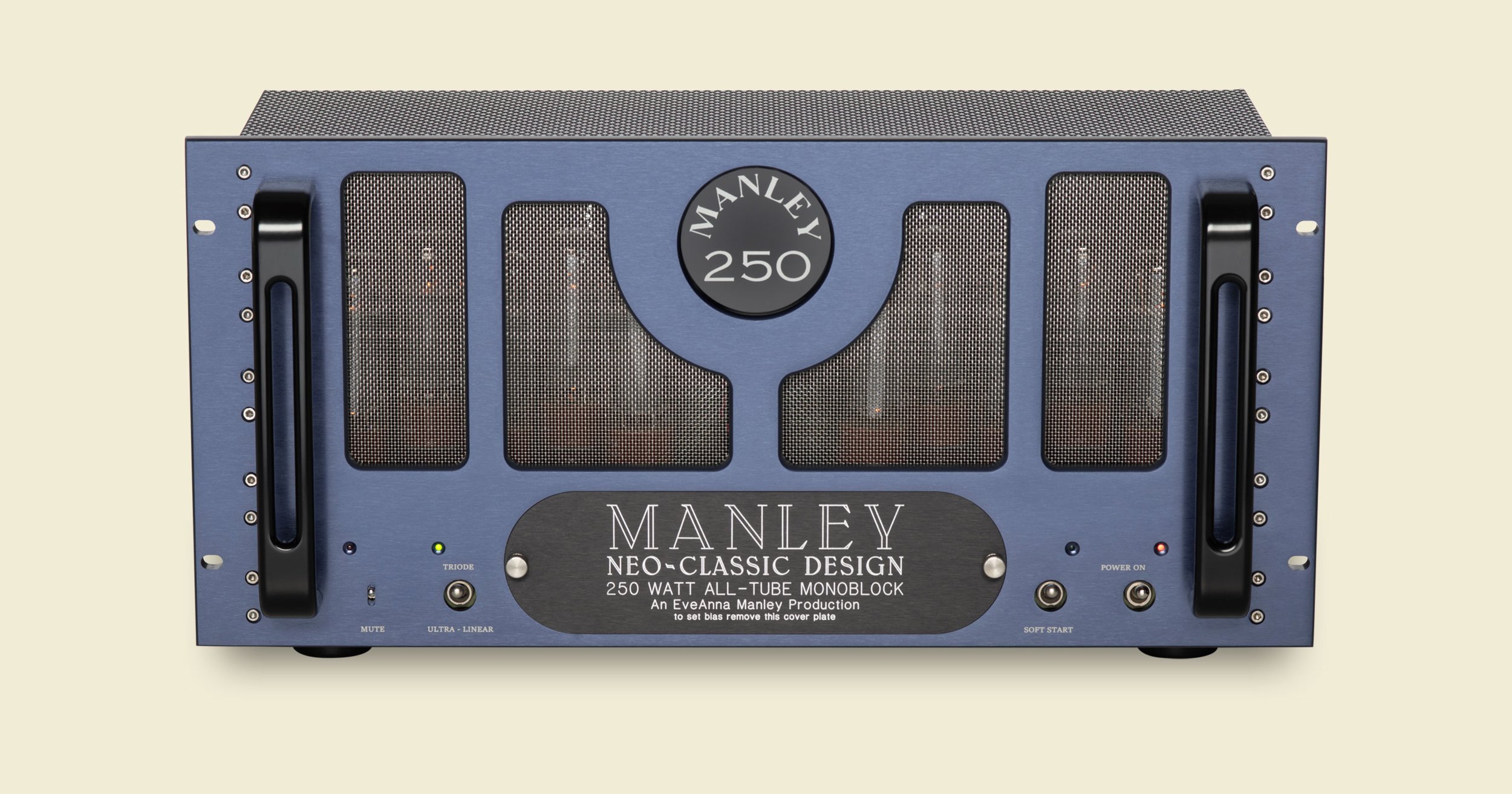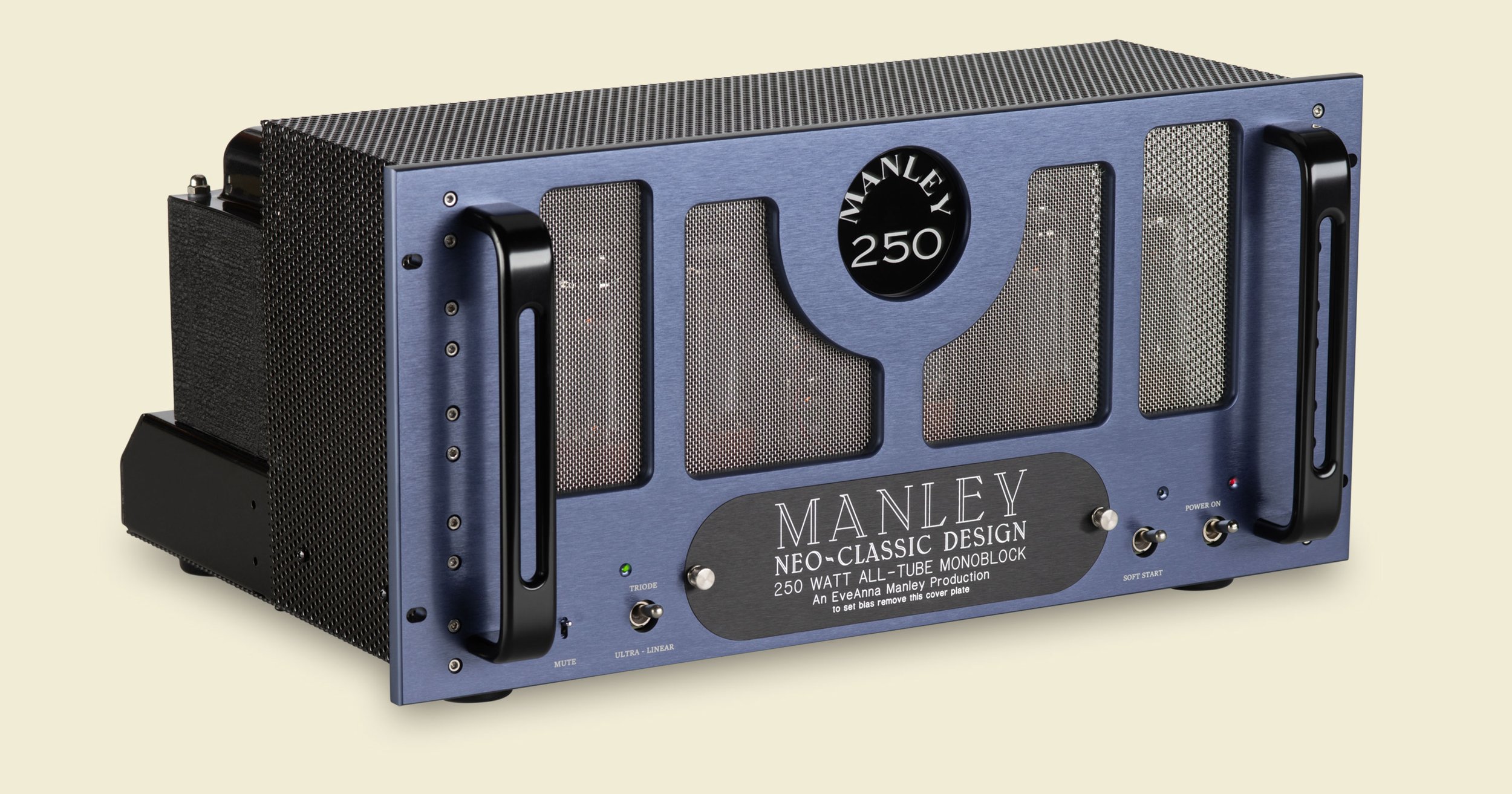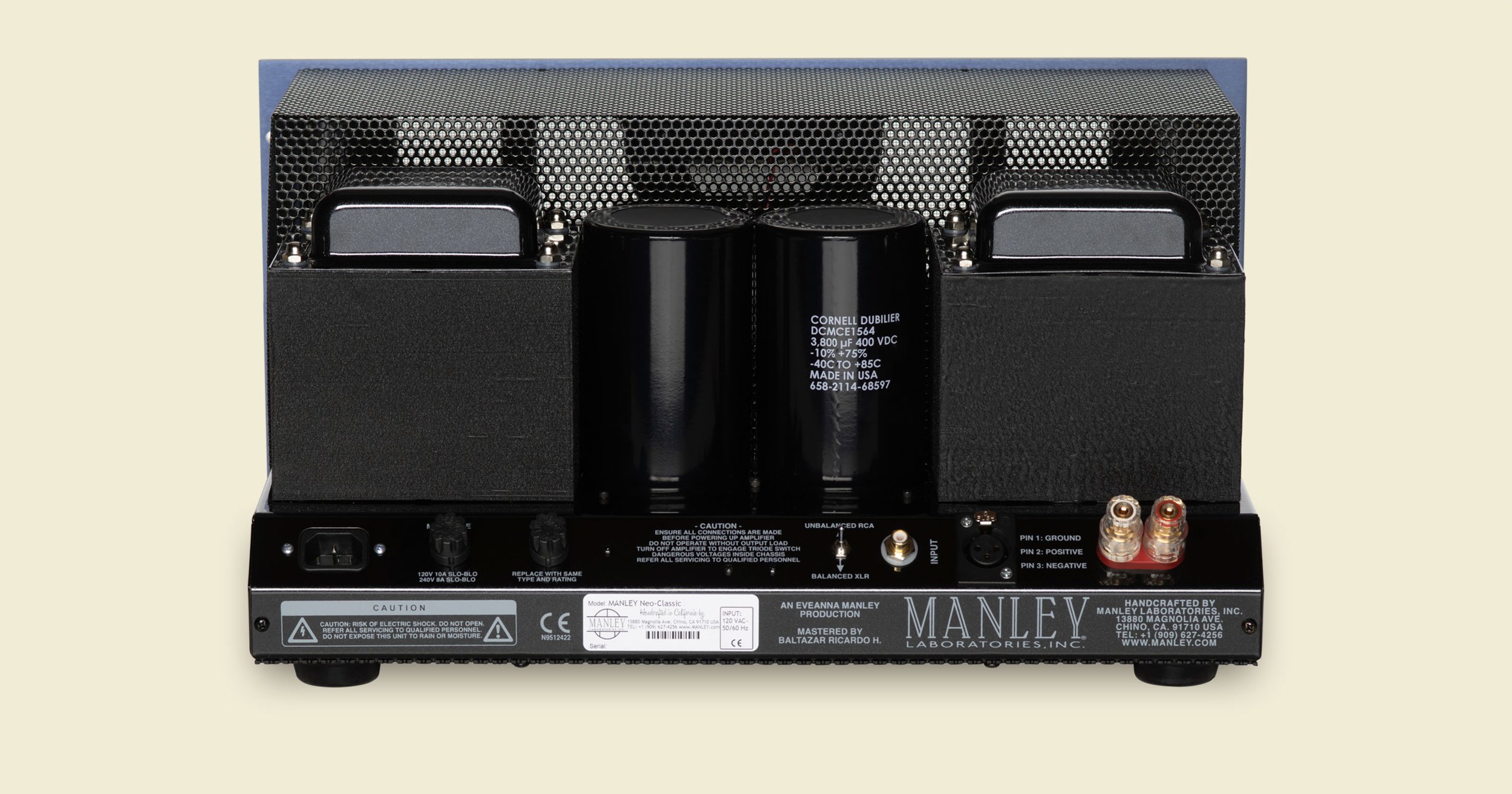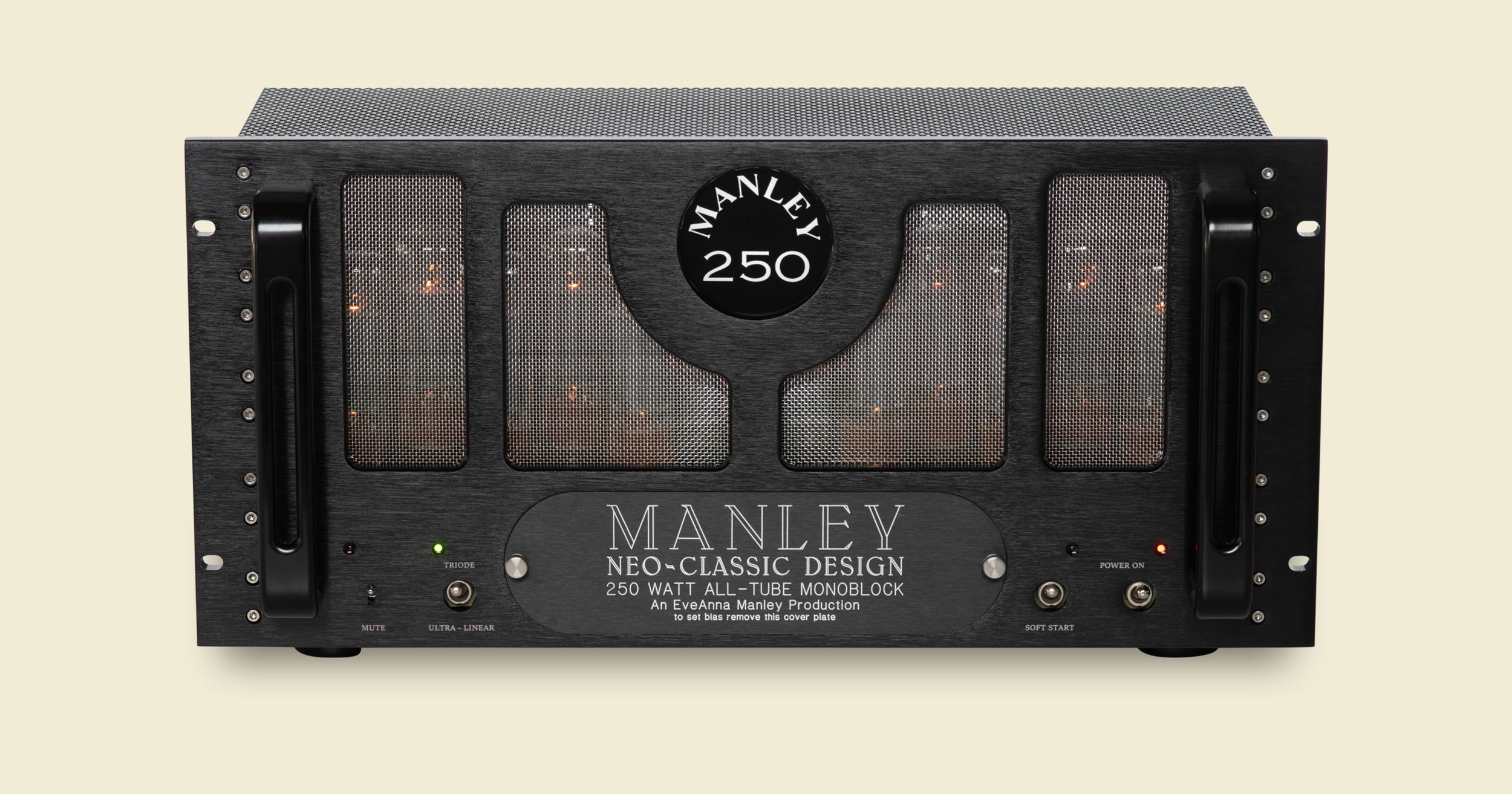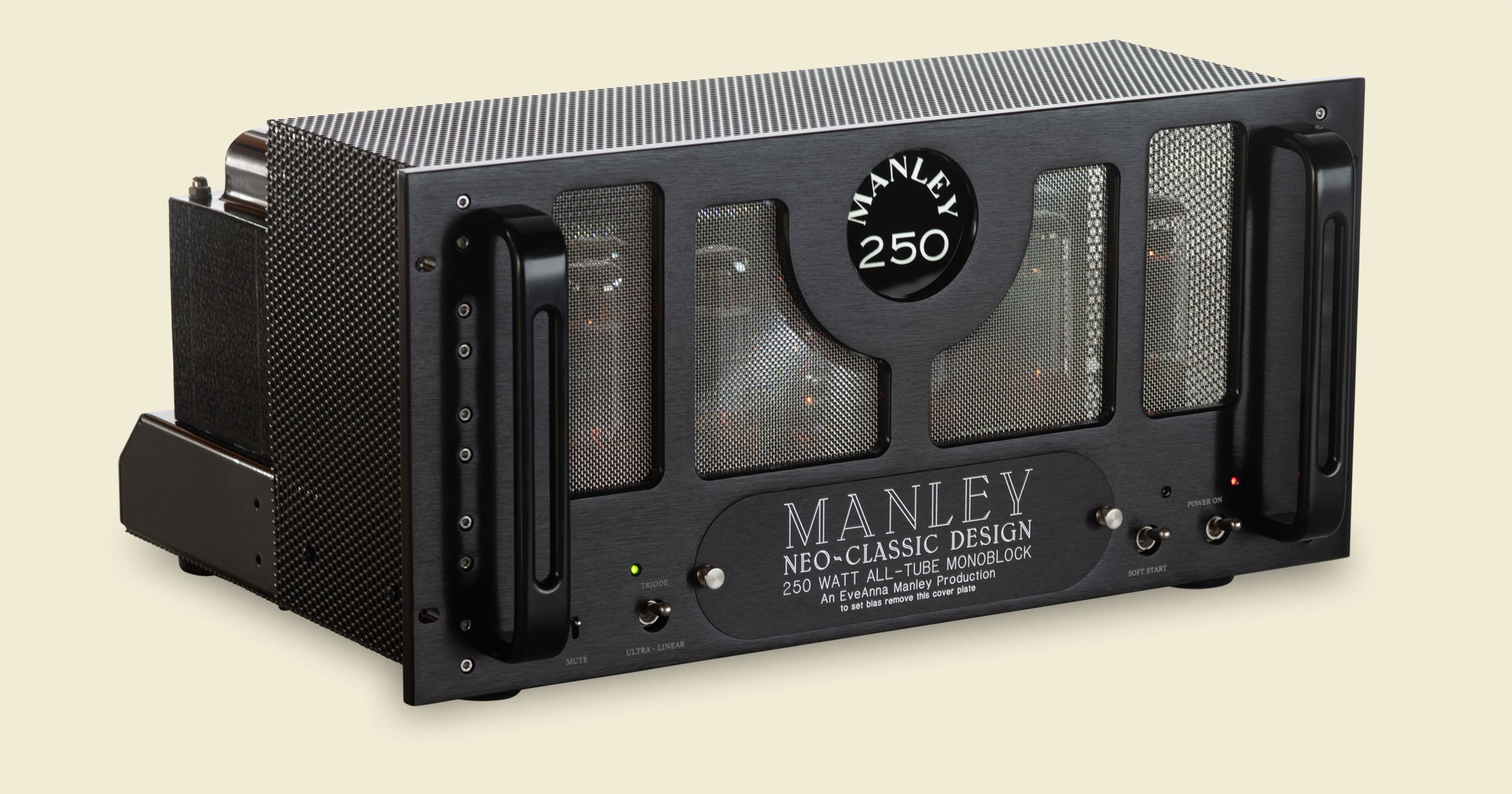
Delivering emotion and translating with pure seductive capabilities the essence of music, the Neo-Classic 250 relies on decades of circuit refinement with proven componentry that maximizes this classic push-pull design. Choose either the sonically seductive qualities of triode or the more powerful Ultra-Linear configuration. The big beefy capacitors provide instant energy for dynamic performance of transient peaks and powerful bass impact.
"They have great control, power, and coherence. They possess great extension in both high and low, and do it effortlessly. At no time did I feel they were straining…What you get is classic workmanship, honest reproduction, and a hint of a vintage vibe that more people are coming to appreciate...Tubes Rule!"
- Al Chieng, Positive Feedback, October 2019 -

DETAILS
A magazine reviewer once wrote the following about the Triode-Tetrode switching version of Manley 250's: "In triode mode a pair of Manleys produces a remarkably three dimensional soundfield that is both convincing and seductive. When switched into tetrode mode, the Manleys have the brawn to deliver a full symphony orchestra directly into your living room." "When I listened through the same cut through the triode mode tube amps, I cried. Yup, tears ran down my cheeks while I bounced up and down, waving my arms, physically buffeted by the raw emotion of the music. Emotion- that essential component at the very core of great music. The Manleys pass through that emotional information, but the (solid-state amps) don't." Tried and true: The Manley 500 and 250 Watt Monoblocks are our most powerful push-pull production-models. Both the circuit design and the selected componentry have been refined over years and years of development. Reliability that you can depend upon combined with musical accuracy and emotional authority is what these amplifiers promise- and deliver. They are able to switch operation modes allowing the listener to choose between the sonically seductive qualities of triode and the more powerful Ultra-Linear configuration. We use big, beefy reservoir capacitors in the high voltage supplies giving plenty of instant energy for dynamic performance of transient peaks and bass impact and weight which often exceeds that of rival solid-state amplifiers. We run high voltages on the plates of the output tubes but operate them at lower current which will result in their longer life. Although each output tube has its own bias-adjust, We carefully fit each amplifier with computer-batched tubes for optimum performance. The bias adjustment pots and measuring points are conveniently located behind the oval front panel insert.
To avoid a heavy power drain when the cold amplifier is first switched on, we conceived a "Soft-Start" mode which also functions as an "Ever-Warm" position allowing the amplifiers to be always warmed up for pleasurable listening. Each amplifier only consumes 30 watts of power in Ever-Warm mode. A blinking green LED reminds the user that the amplifier is in warm-up mode because as all the power supplies are at half-voltage, the amplifier will still operate at half power when the Ever-Warm mode is engaged, so the user should use the MUTE switch when in this mode.
The front-panel mute switch and angled-back chassis make it easier to hook up the interconnects, speaker cables, and IEC power cord.
In our own in-house magnetics department, our R&D team completely redesigned all of our output transformers in 1998 with the goal to reclaim that luscious rich mid-range of our vintage designs. In 2013 we reworked the output transformer to operate the output stage in Ultra-Linear mode which is a great sounding balance between the detail of triode and the brawn of Tetrode. We also specifically set out to achieve a deeper bottom register at higher power with lower distortion. Hours and hours of listening tests, measurements, and fine-tuning brought an exciting and stunning result to our ears. We hope you will agree.
SPECIFICATIONS
ALL-TUBE monoblock design: uses 10 x Tungsol EL34B output tubes
Driver Stage: High current double 12BH7EH (x2)
Input Tube: 12AT7
BALANCED & UNBALANCED inputs: RCA and XLR jacks (switchable)
MANLEY IRON® Input Transformer for the XLR: 2:1 ratio designed and wound at Manley Labs
MUTE switch: on front panel
TRIODE / Ultra-Linear output mode switching: on front panel
SOFT-START turn on mode: minimizes in-rush current by first powering up amplifier to half voltages
EVER-WARM mode: for standby keeps tubes warmed up at half voltages
MANLEY IRON® Output Transformer: designed and wound at Manley Labs
Front panel bias measurement and adjust: Concealed under the black oval insert
Output Tube Standing Current: 30mA
Set Bias for: 300mVDC measured across each bias tip jack to ground
Large filter / reservoir capacitors: 3800uF x 2
Angled rear of chassis: provides for easy connections
WBT binding posts: CE compliant for European models
Input Sensitivity RCA: Triode = 1.17 V; UL = 1.38 V for full power into 5 Ohms
Input Sensitivity XLR: Triode = 2.56 V; Tetrode = 3.05 V for full power into 5 Ohms
Input Sensitivity RCA Triode: 98.3 mV; UL = 86.6 mV for 1 Watt into 5 Ohms
Input Sensitivity XLR Triode: 227 mV; UL = 200 mV for 1 Watt into 5 Ohms
Gain RCA: Triode = 27.2 dB; UL = 28.3 dB
Gain XLR: Triode = 21.2 dB; UL = 22.3 dB
Input Impedance RCA: 130 kOhm @ 1KHz
Input Impedance XLR: 278 kOhm @ 1KHz; 20 kOhms @ 20KHz; 28 kOhm @ 20Hz
Actual Output Impedance Triode: 0.610 Ohm
Actual Output Impedance Tetrode: 0.698 Ohm
Optimum Speaker Load: 5 Ohms
Damping Factor Triode: 13.1
Damping Factor Tetrode: 11.5
S/N Ratio: 94 dB A-WGT at 1 Watt into 5 Ohms
Dynamic Range: 114 dB A-WGT
Noise Floor: -84 dB or 50 µV A-WGT 1 Watt into 5 Ohms w/Shorted Input
Frequency response -1 dB: Triode = 10 Hz - 30 kHz
Full Power frequency response -1 dB: Triode = 10 Hz - 33 kHz; UL = 10 Hz - 20 kHz to reach 1.5% THD into 5 Ohms
Distortion: Triode = 0.052%; UL = 0.37% BW 10 Hz - 500 kHz at 1 Watt into 5 Ohms
Full Power Triode: 140 W @ 1.5% THD into 5 Ohms
Full Power UL: 250 W @ 1.5% THD into 5 Ohms
Power Consumption: 40 Watts in "EVER-WARM" mode
Power Consumption Idle: 335 Watts
Maximum Power Consumption: 710 Watts at full power
Operating Mains Voltage: Factory set for 100V, 120V or 220-240VAC operation for original destination country's mains voltage.
Operating Mains Voltage: changeable with power transformer replacement and fuse value change.
Mains Voltage Frequency: 50 Hz or 60 Hz
Mains Fuse 100-120VAC operation: MDA 10 Amp SLO-BLO Ceramic Time-Delay fuse
Mains Fuse 220-240VAC operation: MDA 8 Amp SLO-BLO Ceramic Time-Delay fuse
B+ Fuse: MDA 1 1/2A SLO-BLO Ceramic Time-Delay fuse
Badge Illumination: Units produced before 4/2003 use 8V, 0.3A "Fuse-Lamp" 1/4" X 1 1/4"
- Serial numbers after N250188 use LED illumination which probably won't burn outPower Cord: Detachable IEC standard. Appropriate power cord supplied for destination country
Unit Dimensions: W=19" x D=13" x H=9" each
Unit Weight: 69 lbs. each
Shipping Box Dimensions: 22” x 19” x 18”
Shipping Weight: 79 lbs. each
Prior Production Models with Triode-Tetrode Switching
Input Sensitivity RCA: Triode = 1.637 V, Tetrode = 1.837 V for full power
Input Sensitivity XLR: Triode = 3.2 V, Tetrode = 3.6 V for full power
Input Sensitivity Triode: 174 mV for 1 Watt into 8 Ohms
Input Sensitivity Tetrode: 146 mV for 1 Watt into 8 Ohms
Gain Triode: 30 dB
Gain Tetrode: 32 dB
Input Impedance RCA: 116 kOhm @ 1KHz
Input Impedance XLR: 270 kOhm @ 1KHz; 20 kOhms @ 20 kHz; 38 kOhm @ 20Hz
Actual Output Impedance Triode: 0.538 Ohm
Actual Output Impedance Tetrode: 0.465 Ohm
Damping Factor Triode: 14.8
Damping Factor Tetrode: 17.2
Full Power Tetrode: 250W @ 1.5% THD into 5 Ohms
Full Power Triode: 100W @ 1.5% THD into 5 Ohms

REVIEWS
"They have great control, power, and coherence. They possess great extension in both high and low, and do it effortlessly. At no time did I feel they were straining…What you get is classic workmanship, honest reproduction, and a hint of a vintage vibe that more people are coming to appreciate...Tubes Rule!"
- Al Chieng, Positive Feedback, October 2019
"The 250 Neo-Classic had that hard-to-define quality that is instantly apparent when heard: a fundamental fidelity to the music...Its sonic personality was honest to the core and completely unfussy, treating music as a thing to be loved and cherished, not as a collection of sounds to be picked apart and analyzed to death."
- John Atkison, Stereophile Magazine, September 2002
"This is the first time in the almost twelve years I've owned my speakers that I've felt like they could be holding the rest of my system back. It is possible that more performance is available from the Neo-Classic 250s, which would make their performance even more remarkable."
- John Kotches, Home Theater Hifi, May 2001
"The Manley 250's never miss giving the listener something of the music and everything that goes into making it...if there is an emotional charge in the playing or the writing or better yet, both, the Manley 250's reward you in spades."
- Rick Jensen, EnjoyTheMusic.com, December 2002
"They not only delivered the true audiophile high-end accuracy and musicality, but also seemed to enable a more intimate appreciation of the sonic nuances than you would likely encounter with most solid-state amplifiers."
- Perry Sun, Widescreen Review, June 2004
"...if you value musicality over anything else...the Manley 250s could be the last amplifiers you ever need to buy. With all that power on tap, you can pretty much swap speakers to your heart's content and not need to make an amp change."
- Jeff Dorgay, TONE! Magazine, September 2007
"Latest upgrade to my Manley system - the Neo-Classic 250W - adding another level to what it is all about: musicality. The Manley set-up is making the Harbeth monitors rock - and keeps my foot tapping. Amazing stuff."
- Rene R., Customer in Denmark
“These amps have allowed me to enjoy my system so much more and now I can listen to regular non audiophile music that would normally chase me out of the room. The Neo Classic 250’s have all I could ask for!! – great bass, clean clear treble, and a liquid midrange that lets me hear much more information on all of my music I have listened to thus far.”
- Michael A, Manley Customer

RESOURCES
FREQUENTLY ASKED QUESTIONS
What tubes should I get for my Manley 250's?
If you are retubing, we would suggest the stock original tubes; you can order a complete matched set on our webstore. For the output tubes, we use the Tungsol EL34B. For drivers we use EH 12BH7s. The 12AT7 input tube is very common, and we use the Tungsol version here. We are personally a little afraid of untested "new old stock" tubes at high prices. There may be a reason they have been kicking around for 30 years. And also as we run each and every tube we put in all of our gear through a battery of noise, operation, gain, and matching tests and purposefully select every tube specifically for best performance in that specific product and circuit, we think we are putting the very best tubes in Manley gear that we can possibly put in there.
How do I re-pack the box? The foam pieces confuse me.
How do I bias my amplifier?
All of the sudden my amplifier is producing no sound! I double checked my cables and sources. All the tubes are reading normal bias. I exchanged the input and driver tubes with the other channel and this amp is just dead. But why?
OK, you have no sound on one of the amps, but the tubes are biasing. That tells us the output tubes & output stage are working. First step is to make sure that the BALANCED/UNBALANCED switch is set to the appropriate position. Second step is to exchange the signal cables coming from the preamp from right to left to ensure the unit is actually getting signal. If it has a bad input or driver tube(s), it will be silent as well. Exchange the input and driver tubes one at a time with the other amp.
(Customer reported back that the R58 20kOhm 5W WW resistor feeding the input tube’s B+ keeps overheating and dying. But why?)
There really isn't too much to this circuit. That the resistor overheats and fails would mean 1) Shorted or leaky 33uf 450V capacitor at the input tube’s anode resistor; 2) Shorted 12AT7 tube- unlikely that it could handle this kind of current, but possible; 3) Shorted pc board trace or tube socket
Scenario #1 is most likely. Measure the DC voltage at the (+) end where the cap connects (it is probably lower than the 287V shown on the schematic). Turn off the power, bleed down this supply, and lift the (+) lead of the cap. If the voltage goes up, the cap is bad. If it stays low, pull out the tube, then look for shorted traces or burned pc board. I believe the diodes he's talking about are the 3 series zeners that are regulators for the input/drive stage. If one or more are shorted, all of the supply voltage to the input and driver will be low; if they are open it will be high. Neither condition will cause the 20K resistor itself to fail.

